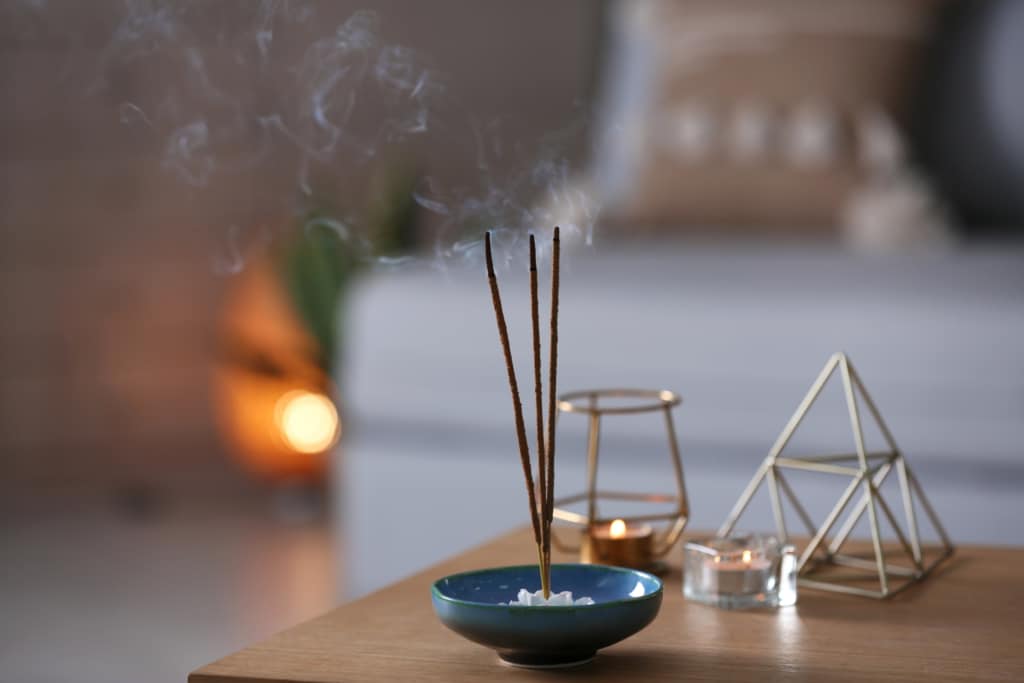
Lighting incense has a way of transforming not just the space around you, but the atmosphere within you. The match strikes, the incense tip glows amber-red, and within moments the aromatic smoke begins to rise: slow, deliberate, mesmerizing. Its fragrance unfurls like a memory, somehow both familiar and otherworldly. Maybe it reminds you of the moment in a yoga studio where you first learned to breathe deeply, or the stillness before meditation when the world falls away, or the silent shift that turns any space into something sacred. Maybe it’s simply the feeling of coming home to yourself.
For most of us, incense has become synonymous with relaxation, something we light to create a mood or “set the vibe.” And while there’s truth in that, incense is so much more. In the modern world, it’s been deeply misunderstood and reduced to mere “nice-smelling smoke” – often dismissed as too strong, too smoky, or written off as nothing more than a cheap air freshener.
Many people don’t realize that incense is one of humanity’s oldest aromatic medicines. Long before essential oils, diffusers, or room sprays – before aromatherapy became a household word – our ancestors were grinding resins, burning sacred woods, and weaving herbs into smoke as offerings, for healing, ritual, and prayer. (Click here to read our blog, “Incense: The Original Form of Aromatherapy.”)
For thousands of years, incense has been a trusted ally, a companion in the rhythms of daily life. Whether to spark creativity, mark the shift from work to rest, invite stillness and spirituality, lift the mood, or support the body’s well-being, incense has always been there, a faithful friend. It’s more than a pleasant aroma – it’s a link to an ancient, holistic way of being.
In this post, we'll explore 5 common myths about incense and uncover the truth behind this ancient, traditional healing art and medicine. Because once you understand what incense really is, you'll never look at that curling smoke the same way again.
Myth #1: "All Incense is Natural"

The Myth
Most incense labels have earthy packaging covered in images of nature. The sticks themselves look rustic, organic, and natural. So naturally, we assume they're made from plants. After all, what else would they be?
The Truth
Here's the uncomfortable reality: most commercial incense contains synthetic fragrances, petrochemical binders, and artificial dyes. There's a good chance that your favorite Sandalwood stick contains zero actual Sandalwood. Instead, you're likely burning a bamboo splint that's been dipped in a chemical cocktail of synthetic fragrance oils and dipropylene glycol (a petroleum-derived solvent), and colored with artificial dyes to look like it contains real plant material.
The fragrance industry has become extraordinarily good at replicating natural scents in laboratories. They can make something smell vaguely like Sandalwood, or Frankincense, or Dragon’s Blood, but these synthetic approximations lack the complex aromatic profiles and therapeutic properties of the real plants. More concerning, many of these synthetic ingredients haven't been thoroughly tested for inhalation safety.
Traditional natural incense is an entirely different form using only pure botanicals: aromatic resins like Frankincense and Myrrh, precious woods such as Sandalwood and Agarwood, medicinal herbs like Rose and Lavender, warming spices like Cinnamon and Clove, and natural binders like Makko powder (made from the bark of the Japanese Bay tree, which has natural adhesive properties and burns cleanly with minimal scent of its own).
There are no shortcuts or chemical fillers – just pure plants, carefully chosen and skillfully blended. Each plant brings its own intention, its own purpose, its own therapeutic properties, and its own voice to the blend.
How to spot the difference between synthetic and natural incense:
Myth #2: "Incense Smoke is Bad for You"
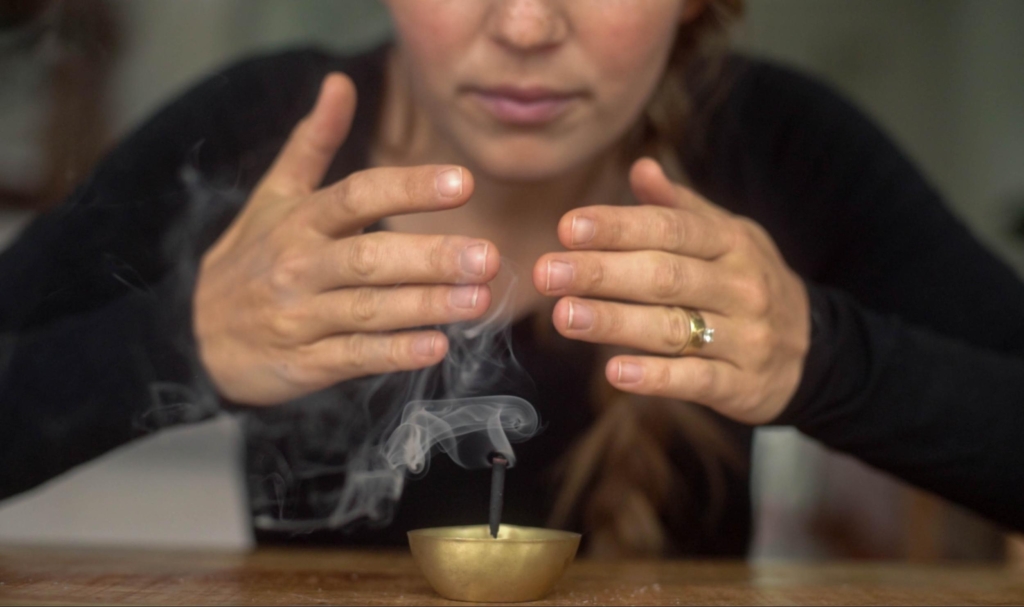
The Myth
This is perhaps the most common concern we hear: "Isn't burning incense bad for your lungs?" Many people have read warnings about indoor air quality, or they've personally experienced headaches, sinus irritation, or even nausea after burning incense. So they've justifiably concluded that all incense smoke is harmful and should be avoided.
The Truth
This isn't a simple yes-or-no question – it's a question of quality. There’s a world of difference between synthetic smoke and aromatic plant smoke. When people experience headaches, nasal discomfort, or lung irritation from incense, they're usually reacting to synthetic chemicals, not to the gentle, therapeutic compounds found in natural resins and aromatic plants.
That’s because mass-produced commercial incense is often loaded with:
- Synthetic fragrance oils derived from petroleum
- Dipropylene glycol (DPG), a solvent that helps bind fragrance oils to the stick but creates harsh, irritating smoke when burned
- Saltpeter, aka potassium nitrate, a chemical accelerant used to help incense burn evenly and stay lit (also found in fertilizer, gunpowder, and preservatives)
- Artificial colorants that release toxic fumes when combusted
- Wood powders and fillers from unknown sources, sometimes treated with chemicals
These chemicals create harsh, acrid smoke that can irritate our sensitive respiratory systems. Natural incense, on the other hand, produces a cleaner aromatic smoke that has been used therapeutically for thousands of years. In Ayurveda, Traditional Chinese Medicine (TCM), and Indigenous healing traditions around the world, specific plants are burned for their therapeutic properties: to calm the mind, open the lungs, purify the air, and support emotional balance.
That said, moderation and good ventilation are key. Burn incense in well-ventilated spaces, for shorter periods, and with intention. Natural aromatic plant smoke should uplift, not overwhelm. Incense is meant to support you, not to cloud your air or irritate your senses. (To learn how to minimize smoke while burning incense, check out our blog: 3 Virtually Smokeless Ways to Burn Incense.)
Myth #3: "Incense is Only Good for Covering up Bad Smells"
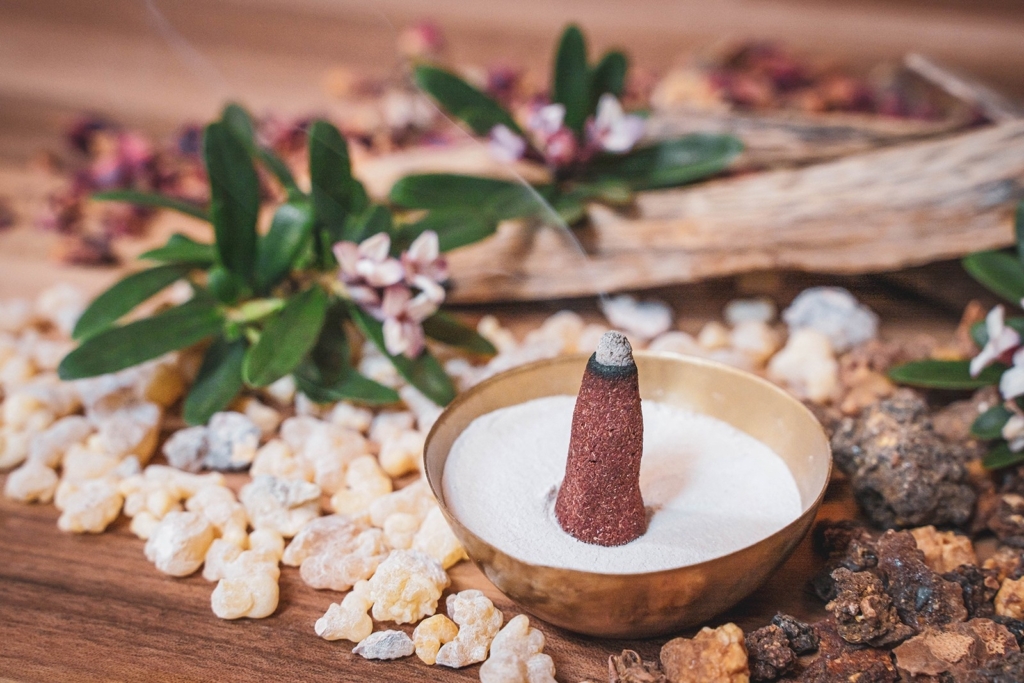
The Myth
Walk down the incense aisle of most stores and you’ll see it marketed like an air freshener: “Eliminate odors!” “Freshen your home!” Modern culture has reduced incense to something utilitarian, a way to mask the smell of cooking, pets, or stale air. It’s been lumped in with candles and room sprays, stripped of the deep medicinal and spiritual roots that have defined its use for thousands of years.
The Truth
Nothing could be further from incense’s true purpose. Traditionally, incense was never about covering things up — it was about transformation, purification, and elevation. It’s the original form of aromatherapy. Long before essential oil diffusers existed, humans understood that aromatic smoke carries powerful compounds that influence both body and mind.
When we inhale the smoke of certain aromatic plants, volatile molecules travel directly to the limbic system, the seat of emotion, memory, and instinct. This is why a single curl of Copal resin smoke can bring instant calm, or why burning Mugwort before bed can guide the mind into vivid, restorative dreaming.
But incense doesn’t just affect the psyche — it can also support physical health. Many traditional incense plants can clear the air of pathogens, open the lungs, and strengthen the body’s natural defenses:
- Eucalyptus has long been used to sharpen the mind and purify the respiratory system. Its aromatic compounds act as natural decongestants and antimicrobials, helping to ease coughs, colds, and chest tightness.
- Clove, revered in both Traditional Chinese medicine and Western traditions, has potent antibacterial, antiviral, and antiparasitic properties. It’s been burned as a fumigant to disinfect air and ward off infection, acting as a natural purifier long before modern medicine caught up [1].
- Frankincense, Juniper, Copal, and Patchouli all share similar gifts — antimicrobial, expectorant, and immune-supportive actions that can cleanse the air while calming the mind and balancing the emotions [1].
The list could go on and on. True incense doesn’t mask unwanted smells — it harmonizes the atmosphere. It clears stagnant energy, purifies the air, and restores balance on every level: physical, emotional, and energetic. When you burn natural incense, you’re not hiding or covering up anything. You’re transforming the space (and yourself) through the alchemy of smoke, scent, and intention.
Myth #4: "Incense is Just for a 'Vibe'"

The Myth
In modern culture, incense has been relegated to aesthetic territory. It's something you burn to set a mood, to create ambiance, or to make things feel a certain way. It's decorative, not functional.
The Truth
While incense certainly does create atmosphere (and there's nothing wrong with that), reducing it to "just a vibe" misses the profound depth and intention behind ages of use. Incense has been used across cultures as a bridge between the physical and spiritual realms – a tool for healing, transformation, and connection to something greater than ourselves.
In Ancient Egypt, priests burned Kyphi (a complex blend of 16 ingredients) in temples at sunset as an offering to the sun god, Ra. Each ingredient was chosen for its specific effects on consciousness and to honor the divine. In Japan, the practice of kōdō is considered one of the classical Japanese arts, alongside tea ceremony and flower arrangement. Participants gather to "listen" to incense in a highly refined, meditative practice that cultivates presence, discernment, and aesthetic appreciation.
In Tibetan Buddhism, incense offerings are made daily as part of devotional practice, and specific blends are used for different purposes. The aromatic smoke is believed to carry prayers and intentions skyward. In Indigenous traditions throughout the Americas, sacred smoke is used for cleansing, protection, and communication with ancestors and spirits. In Ayurveda and TCM, specific aromatics are prescribed therapeutically, burned as part of comprehensive healing protocols that address body, mind, and spirit simultaneously.
Learn How to Make Irresistible Incense For
Enjoyment, Healing & Ritual with
✨ The Art of Incense Crafting Ebook ✨
Download Your Free Copy Below

Are you ready to learn how to craft your own natural incense? This free eBook covers the essentials of creating incense that burns beautifully and smells divine, exploring its role as an ancient aromatic medicine and sacred ritual tool. Avoid common pitfalls and unlock step-by-step instructions to make incense cones with ease.
The effects of incense work on multiple levels simultaneously:
Emotional balance: Certain plant compounds can calm the nervous system, ease anxiety, uplift mood, or ground scattered energy.
Energetic cleansing: While Western science doesn't have great language for this yet, countless traditions recognize that spaces hold energy: the residue of emotions, events, and intentions. Smoke, particularly from certain resins and herbs, is believed to clear this energetic buildup, essentially resetting a space.
Spiritual significance: Burning incense is an act of devotion, a way of marking time as sacred, of creating a container for prayer or meditation. Evan the ritual itself – the striking of the match, the lighting of plants, the watching of smoke – cultivates presence and reverence.
Connection to the divine: In many traditions, smoke is seen as a vehicle that carries prayers, gratitude, and intentions from the earthly realm toward the heavens. The act of burning incense becomes a form of communication, of offering, of remembering that we're part of something vast and mysterious.
Myth #5: "Making Incense is Complicated and Requires Special Tools"
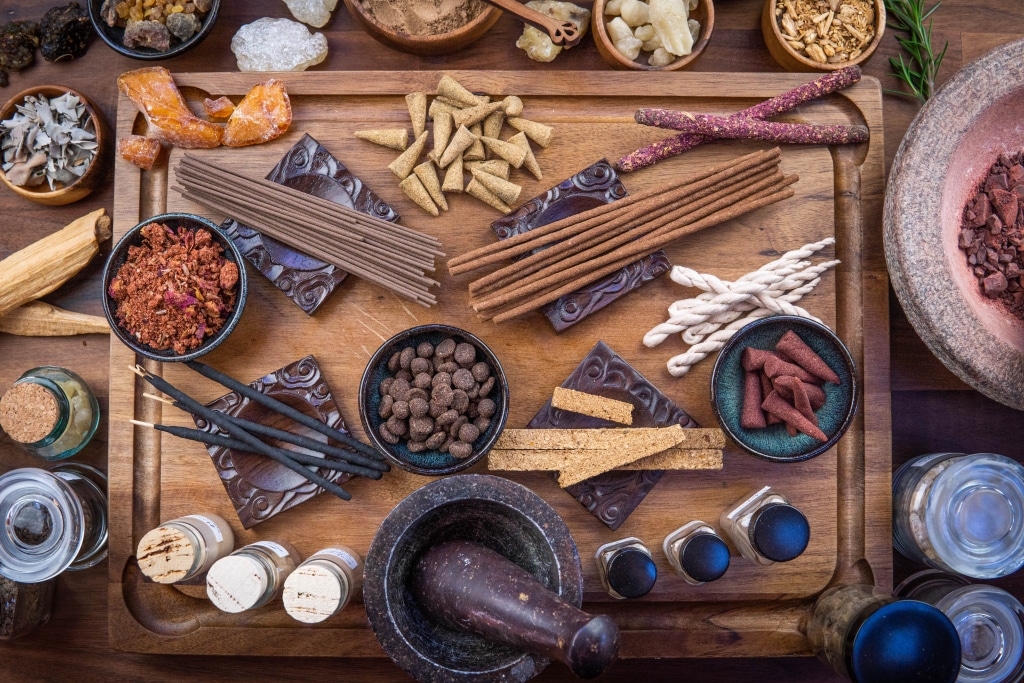
The Myth
When most people imagine making incense, they picture something grand and inaccessible: a secret art requiring rare ingredients, specialized equipment, years of training, or maybe even mystical initiation. It feels like something that happens behind closed doors in temples or apothecaries, not something an ordinary person could do in their own kitchen.
The Truth
Here's the beautiful secret: making traditional incense is remarkably within reach. All you need are a few basic tools like a mortar and pestle, a small bowl, some foundational knowledge, and access to natural botanicals. That's it.
The process itself is sensory, creative, and deeply meditative. You grind resins by hand, feeling their texture change, releasing waves of aroma with each turn of the pestle. You blend herbs and woods, adjusting proportions by intuition and scent. You shape the mixture with your hands, connecting directly with the materials. It's a practice of slowing down, of paying attention, of reconnecting with plants and the rhythms of nature.
There's no need for fancy equipment or industrial machinery. Traditional incense-making is a craft of simplicity and presence. You learn by doing, by smelling, by observing how different resins and herbs mix and how various herbs release their scent. It's tactile, embodied, and accessible to anyone willing to begin.
And most importantly, you don't need to get it "perfect." Your first incense might burn unevenly or smell different than you expected. That's not failure – that's learning. Every traditional incense maker has stories of early experiments that didn't quite work. Those "mistakes" are how you develop your understanding.
This is an accessible, therapeutic, and meditative art that anyone can begin. You don't need special permission or years of training before you start. You need curiosity, respect for the plants, and a willingness to learn. The practice will teach you. Your hands will develop memory. Your nose will become more discerning. And gradually, you'll find yourself able to create incense that serves specific purposes, that carries your intention, that feels right in ways you couldn't have articulated when you started.
The grinding, the blending, the shaping – these actions become forms of meditation, of prayer, of art, of reconnecting to the wisdom held in plants. This is a medicine in its own right, not just because of what you create, but because of what the process offers: patience, presence, connection, and the satisfaction of working with your hands to make something beautiful and meaningful.
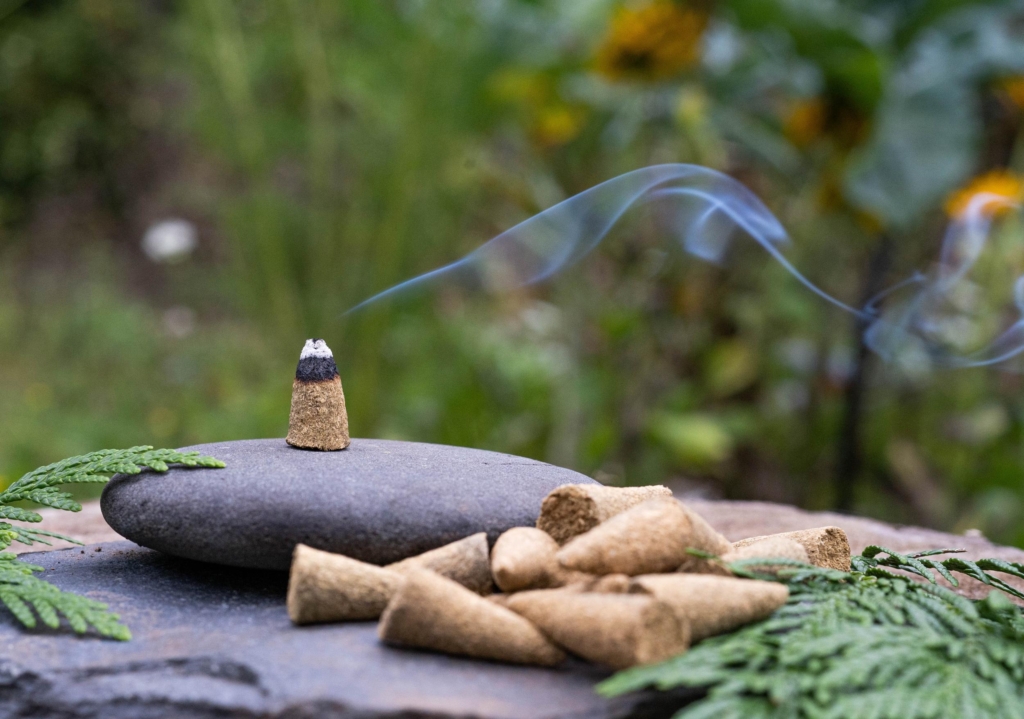
Traditional Natural Incense: Returning to the Heart of the Practice
Incense isn't just fragrant smoke; it's a connection to plants, nature, tradition, and ourselves. It's creativity: the art of blending, shaping, and honoring the aromatic gifts of the earth. And it's medicine: subtle, holistic, and deeply felt.
For too long, incense has been misunderstood, dismissed, or diluted. But beneath the synthetic sticks and mass-market fragrances, there's a tradition waiting to be rediscovered. Incense is an ancient healing art, a form of communion with the natural world, a practice that invites us to slow down and recenter.
When you light truly natural incense, you're not just setting a mood; you're reigniting the ancient knowing that scent is sacred, that pure plant smoke carries intention and medicine, and that the simplest rituals can be the most transformative.
If you've ever wanted to learn the art of making pure, natural incense, from the rich history and materials to the hands-on craft itself, stay tuned to learn how to step into this ancient aromatic practice. We have a special announcement coming next week. The door is open. The plants are waiting. And the journey begins with a single spark.
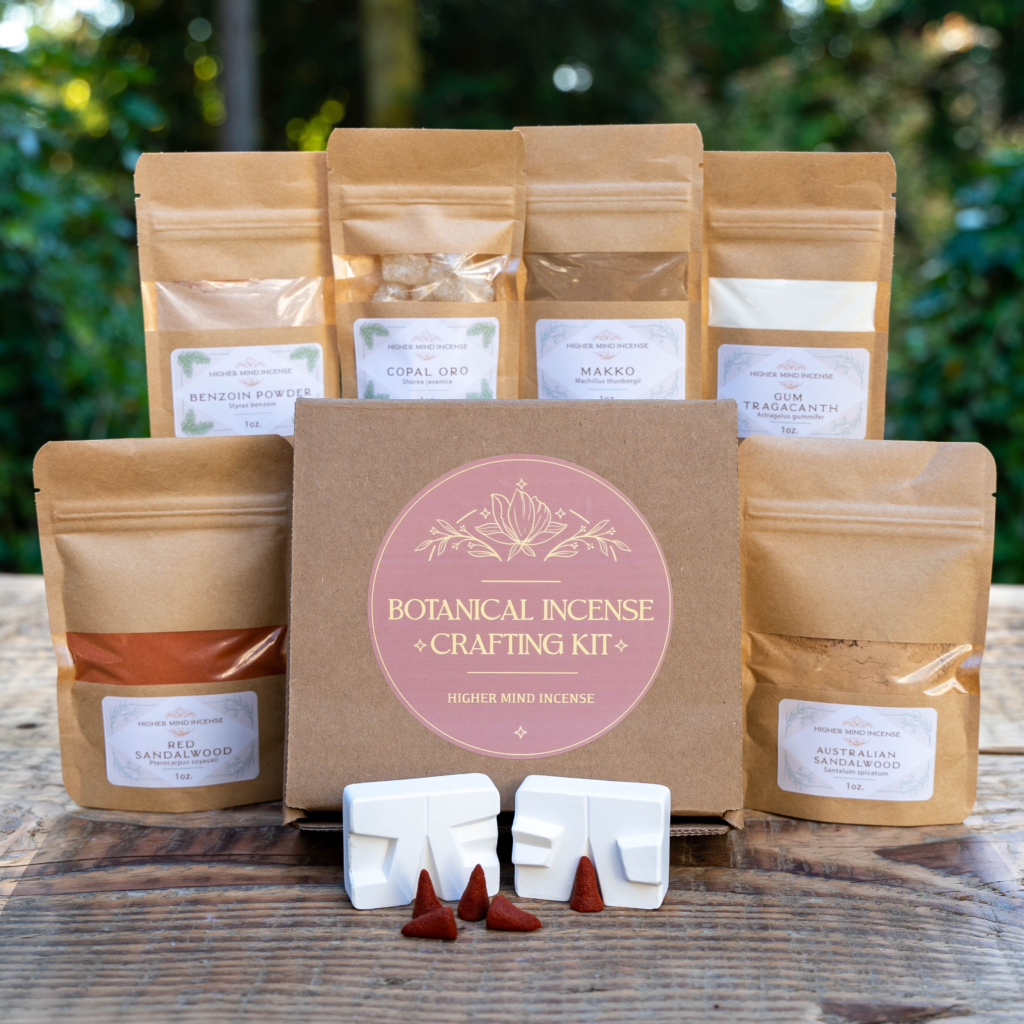
✨ Awaken your inner incense maker. ✨
With our Botanical Incense Crafting Kit, you’ll easily transform fragrant herbs and resins into sacred aromatic creations that carry your own energy, purpose, and signature scent.
This all-in-one kit includes everything you need: pure natural ingredients, an incense cone mold, easy-to-follow recipes, and a FREE Incense Crafting ebook to guide you every step of the way. No guesswork, no synthetic fillers, just pure plant alchemy.
Perfect for gifting or for crafting beautiful, handmade natural incense to share this holiday season!
Article Written By Melissa Szaro

References
1. Syliassen, Evan. Materia Aromatica. Higher Mind Incense, 2025.
© 2025 The Northwest School of Aromatic Medicine. All rights reserved.
*The statements above have not been evaluated by the FDA, and are for educational purposes only. This article is not intended to diagnose, treat, cure, or prevent any disease. This article should not be taken as medical advice. Please consult your physician before you use this information for health purposes.
